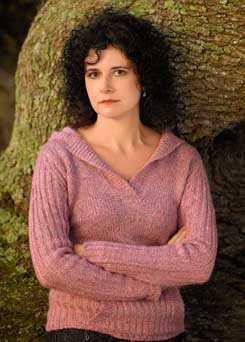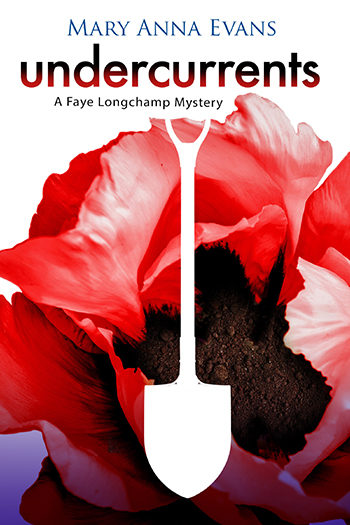 Mary Anna Evans is the author of the Faye Longchamp archaeological mystery series, the 11th installment of which, UNDERCURRENTS, is now available. Her protagonist is an archaeologist who “goes where the history is,” traveling all over the country and solving mysteries along the way. In this blog piece written exclusively for Bookreporter.com, Mary Anna explains why she chose Memphis, Tennessee, as the setting for her latest novel, and talks about the wonderful time she had there as she conducted research with the help of two of her oldest friends.
Mary Anna Evans is the author of the Faye Longchamp archaeological mystery series, the 11th installment of which, UNDERCURRENTS, is now available. Her protagonist is an archaeologist who “goes where the history is,” traveling all over the country and solving mysteries along the way. In this blog piece written exclusively for Bookreporter.com, Mary Anna explains why she chose Memphis, Tennessee, as the setting for her latest novel, and talks about the wonderful time she had there as she conducted research with the help of two of her oldest friends.
My 11th Faye Longchamp archaeological mystery, UNDERCURRENTS, is hitting the streets right…about…now, and it’s set in Memphis, Tennessee. Wherever Faye goes --- Alabama, Florida, Louisiana, New York, Oklahoma, Mississippi or Tennessee --- she has an adventure that she could have no other place. There is only one place to explore the ghostly roots of Spiritualism, and that place is New York. There is only one place to stand on the Mother Mound of the Choctaw, and that place is Mississippi. Faye goes where the history is.
However, she doesn’t travel to a new state with quite every book. For example, Faye has been to New Orleans and its environs twice. (Why? Have you eaten in New Orleans? That’s why. I may need to set another book there soon, because I feel a beignet craving coming on.) She lives in Florida on an imaginary island in the Gulf of Mexico located somewhere near Sopchoppy, so three of the books are set there.
But Faye likes to go new places, and so do I. Thus we went to Tennessee for UNDERCURRENTS, which begs the question of “Why Memphis?”
 My first step in crafting a book for Faye is to choose a place that would be fascinating for an archaeologist. I have always known that I would come to Memphis, with its long history as a port where the whole world comes and goes on a daily basis. (And also, have you eaten the barbecue there?) Memphis has the complicated racial history that comes with being part of the American South. Actually, if we are to be honest with ourselves, all of America has a complicated racial history. I try to address this in my books, because how are we to put that history behind us if we aren’t honest with ourselves?
My first step in crafting a book for Faye is to choose a place that would be fascinating for an archaeologist. I have always known that I would come to Memphis, with its long history as a port where the whole world comes and goes on a daily basis. (And also, have you eaten the barbecue there?) Memphis has the complicated racial history that comes with being part of the American South. Actually, if we are to be honest with ourselves, all of America has a complicated racial history. I try to address this in my books, because how are we to put that history behind us if we aren’t honest with ourselves?
Like Faye, my family has been in the South for many generations. I’m drawn to its physical beauty, and my heart breaks over a troubled past that I suppose I will never stop exploring in my work. Memphis possesses that beauty and that troubled past, so it was inevitable that I would write about it. When I began writing UNDERCURRENTS, I realized that the time has come.
The view from atop the strategic bluffs at Memphis has never left me. Near those bluffs is the Chucalissa Archaeological Museum, surrounded by T.O. Fuller State Park. The park’s natural beauty is surprising, so near to the neighborhoods and industrial fringe of a major urban center. Novelists love the element of surprise, so I decided that this was the place.
I envisioned a serial killer haunting an imaginary park very like the real T.O. Fuller State Park, ceremoniously burying his victims there with bouquets of flowers in their limp hands. I knew that I needed to visit Memphis again to soak up the park’s atmosphere. Because there’s no reason that work can’t be fun, I invited two of my oldest friends to drive up from Mississippi and Alabama, so that they could share my hotel room and help me with my research. (I don’t think that the IRS has any requirement that business travel must be miserable, so we had a good time doing that research. Just in case, though, don’t tell them. Let them think I was unhappy for the entire research trip.)
Carla, Debbie and I checked out the state park and the neighborhoods around it. We toured the Chucalissa museum. We explored Beale Street. We had brunch at the sumptuous Peabody Hotel. (My, how I suffer for my art.) We enjoyed the company of the Peabody ducks and their duckmaster. Most of all, we drove through the neighborhoods surrounding T.O. Fuller State Park, and this helped me create my own neighborhood, a troubled one where the residents deeply need the police but can’t overcome their distrust and fear enough to ask them for help.
I knew how deeply Faye would want to help them. This was an important book for me personally, forcing me to consider the often-fraught relationship between marginalized people and their legal system as I crafted a tale that brought justice to people who haven’t always experienced it. By the same token, I wanted my story to respect and honor the officers who put their lives on the line, day after day, working for nothing less than simple justice.
In UNDERCURRENTS, I’ve built a world where a suffering community gets the help they need, and an honorable police officer receives the respect he is due. Justice is done.
May it ever be so in the real world, too.


